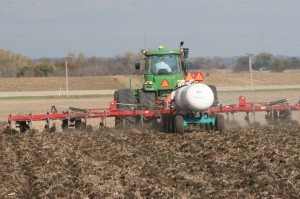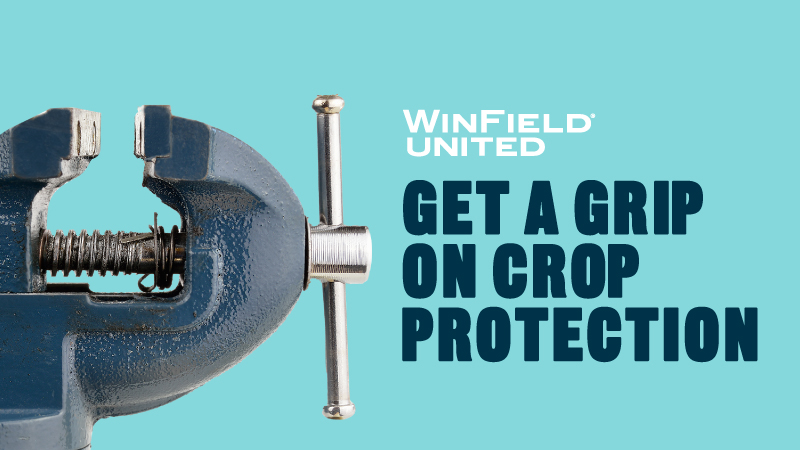N Stabilizers In Play

The use of nitrogen stabilizers has become more popular in recent years as U.S. growers plant more nitrogen-dependent corn in their crop fields.
As highlighted in our final CropLife Media Group e-newsletter of 2012, the third most searched term on our site this past year was nitrogen. One of nature’s most basic and prolific elements is a hot item right now and should continue to be so as growers strive for continued yield growth hand over fist.
Naturally then, nitrogen stabilizers, products that pledge to help reduce nitrogen loss, are providing quite the revenue boost at many ag retailers, including Bambauer Fertilizer and Seed Inc. According to manager Matt Bambauer, the Pemberton, OH-based operation has been evaluating various nitrogen stabilizer offerings in side-by-side research trials for the past four to five years.
“What we’re seeing in our research is, number one, just better yields overall,” notes Bambauer, who says the retailer has found the most success applying nitrogen stabilizer products over top of urea applications. “They’re easy to work with, easy to mix in and they just plain work. I think on average, we’re seeing over a 10 bu./acre better response when using these products.”
Located south of the Western Lake Erie Basin, Bambauer Fertilizer’s location gives them a unique prospective in nitrogen stabilizers as the region is dealing with areas of hypoxia created by elevated nutrient content levels in the lake, much of which is blamed on chemical and fertilizer runoff from agricultural operations.
“We’re also close to another distressed watershed, the St. Mary’s River Watershed, and in our experiences these products are effective in helping keep nitrates out of the water,” says Bambauer.
A Banner Year
Despite being fierce competitors in an extremely competitive market, Specialty Fertilizer Products (SFP), Dow AgroSciences, AgXplore and Koch Agronomic Services all agreed that 2012 was a great year for sales of each respective manufacturer’s nitrogen stabilizer products.
Reggie Underwood, SFP national sales manager, reports positive growth in sales volume across the country, despite the challenges brought on by 2012’s historic drought.
Two products were primarily responsible for SFP’s success, according to Underwood: NutriSphere-N and More Than Manure. NutriSphere-N, which is formulated for both dry and liquid N applications and pledges to reduce leeching and protect N from volatilization, led the way in reduced tillage operations.
“The adoption of reduced tillage practices is increasing across the country, leaving nitrogen applications on those acres highly susceptible to loss. Adding a nitrogen stabilizer such as NutriSphere-N to urea or UAN applications fits in well with minimum-till and no-till scenarios because it helps protect that nitrogen from volatilization,” says Underwood. “The integration of this nitrogen management tool in fertility programs on those acres has added to the success of NutriSphere-N in the marketplace.”
Additional aspects of NutriSphere-N that growers enjoyed this season include the flexibility the product affords in fertilizer application, and of course the yield benefits.
“We’ve got some nice data (from field trials) that shows NutriSphere-N had a nice yield increase, both with 100 and 150 units of N, of around nine bu./acre,” says Underwood. “This trial was done with spring applied urea with NutriSphere-N, as opposed to fall applied anhydrous ammonia. A lot of people talk about the low input cost associated with ammonia, but when you look at today’s corn prices, that nine bushel increase is pretty significant in today’s corn market.”
More Than Manure (MTM), a liquid nutrient management product in manure for both phosphorus and N, launched last February after three years of research and development.
Besides yield benefits, Underwood points to the product’s ability to increase the quality of grain for users.
“MTM can be poured directly into pits and lagoons or sprayed over the top of dry manure spread in the field. ,” says Underwood. “MTM helps keep nitrogen in a stable form available to the crop, which can lead to a healthier plant, improved quality of grain and better yields.”
“The great thing about these products is they provide yet another service that retailers can offer their growers,” he adds. “That ties the retailer closer to the customer, making him a more valuable part of the grower’s operation.”
New Faces
Koch Agronomic Services LLC made a successful foray into the N stabilizer market back in October of 2011 when it acquired the assets of Agrotain International, according to vice president of commercial operations Tom Snipes.
“Last year was our first full year with the Agrotain products being a part of Koch Agronomic Services and we were very happy with the results,” says Snipes. “We’ve actually just recently increased our production capacity to meet increased market demand. When we look at the overall market segment and the science behind our products, we’ve continued to see record usage.”
Two products that contributed to that record usage are Agrotain ULTRA, which according to Snipes saw incredible growth in 2012, and Agrotain PLUS, a product featuring two N-inhibitors that users can add to UAN.
Dr. Greg Schwab, Koch’s agronomy director, adds that SUPERU, a granular urea fertilizer product featuring triple-action to reduce N losses resulting from volatilization, denitrification and leaching, also saw heightened usage in the market as growers reacted to weather uncertainty.
“There’s almost always an uncertainty of how much nitrogen a grower needs,” says Schwab. “Part of that uncertainty is due to the fact that the grower does not know how much loss he will have in a particular season, so by protecting the nitrogen from loss he gains a lot of certainty of how much nitrogen he’s going to need.”
According to Snipes, besides the obvious yield advantages one of the main drivers of adoption of Agrotain products is economic.
“If a grower does surface apply urea, say for example he spends $100 per acre on his nitrogen, if he lost say 30% of that due to volatilization, that’s $30 per acre that he’s losing,” he says. “So with volatile weather increasing the chance of that nitrogen moving off target, these products can be an insurance policy.”
In 2013, Koch looks to release a new formulation of its dry product, offering improved handling over traditional liquid alternatives.
“We really think customers are going to like what they see with this new formulation from a handling standpoint, as well as from an efficacy standpoint,” says Snipes.
Additionally for 2013, Koch plans to continue its heavy investment in science-based marketing efforts, helping growers navigate a market with more and more products making sometimes unsubstantiated claims.
“A lot of product comparison trials on these products are just now getting published,” says Schwab. “University researchers want to have two to three years’ worth of data on a new product before they say whether it’s effective or not. There are a lot of products that came on the market in the last two or three years that farmers didn’t have information from their land grant university on whether those products were effective or not.
“In 2013, we’re encouraging growers and retailers to take a look at those Extension research reports and make the decision on their own about which products are most effective for their particular situation.”
AgXplore is also reportedly expanding its research efforts in 2013 in an effort to better advocate its NZONE product line to growers and retailers.
“Each season, our company goal is to invest in research and development to improve our products,” says Brandon McMillan, director of product development and research. “In 2012, we had over 150 research plots throughout the country evaluating NZONE’s field performance and return on investment and in 2013 we’re looking to continue the positive trend.”
According to McMillan, in 2013 AgXplore is releasing two new technologies in the N-Stabilizer category. “CrossLink Technology will be added to both NZONE MAX and Prevent products,” he explains. “This new technology is designed to improve in-field performance of these products under extreme conditions. TopSide is another new product from AgXplore for 2013, built on the success of our NZONE line. TopSide is designed exclusively for UAN applications and will improve fertilizer efficiency and aid in managing N availability throughout the growing season.”
AgXplore products are prime revenue producers for both growers and retailers as well, adds McMillan. “NZONE not only protects a farmer’s nitrogen in the field, NZONE adds to their bottom line by increasing yields. With the addition of NZONE, growers will see production at a higher level. Lastly, NZONE is cost effective and retailers will secure repeat business while gaining profitability for themselves and the producer.”
The Wily Veteran
With a combined 40 years on the job, N-Serve and Instinct nitrogen stabilizers from Dow AgroSciences are well known and the only two EPA-registered nitrification inhibitors on the market.
“These products are tried, true and university-tested,” says Chris Berry, market developer for Instinct and N-Serve. “Over the years, they have really been put through the wringer, so to speak, on testing and research.”
Citing a 2012 Illinois field trial of N-Serve applied in the spring, corn treated with the product saw an 11-bushel advantage over untreated corn, despite the summer drought. “At today’s commodity prices, that gives a grower a great return on his investment,” Berry says. Early applications in fall 2011 and late-season applications in spring 2012 pushed both products toward record usage in 2012, Berry says.
“Growers and retailers we’ve spoken with were ecstatic with the results of these products,” Berry says. “The two biggest limiting factors to corn production, as most everyone knows, are water and nitrogen.”
Remaining Important
With that in mind, Berry predicts that nitrogen stabilizers will remain a viable service niche for ag retailers, especially with projections of increased climate variability.
“Sometimes people want to react to next year before next year happens,” Berry says. “For instance, I was at a show recently where one gentleman said to me, ‘Well, we didn’t get much rain in my area so I don’t know if I’ll use an N stabilizer next year.’ My response to him was, ‘If you plan for failure, guess what you’re going to get?’
“Dow AgroSciences recognizes that the N stabilizer market is going to continue to be an important market going forward,” he adds. “We plan to continue to invest in this market, coming up with new active ingredients and product reformulations in the next few years.”






